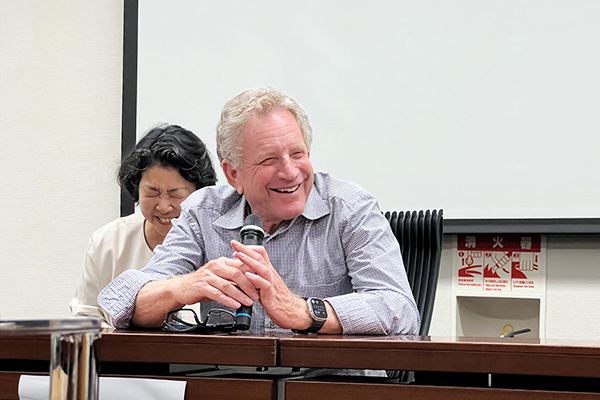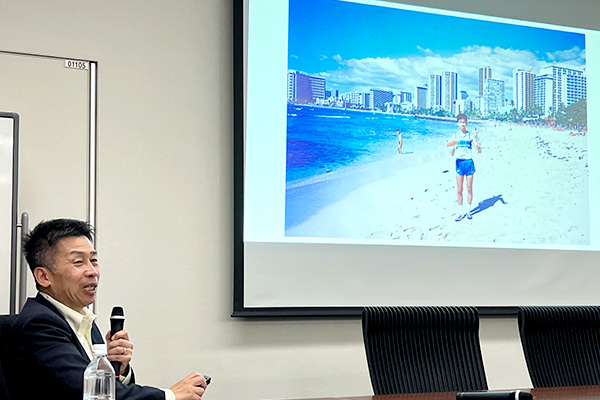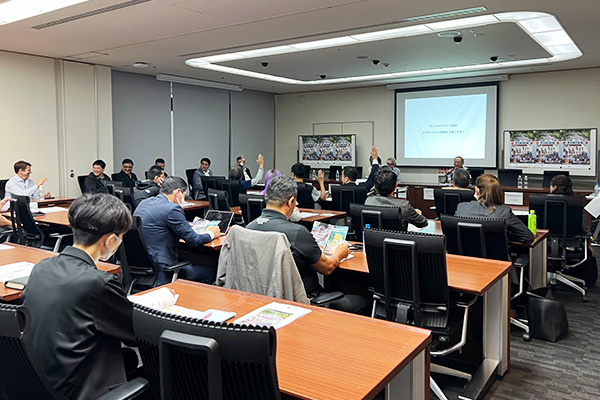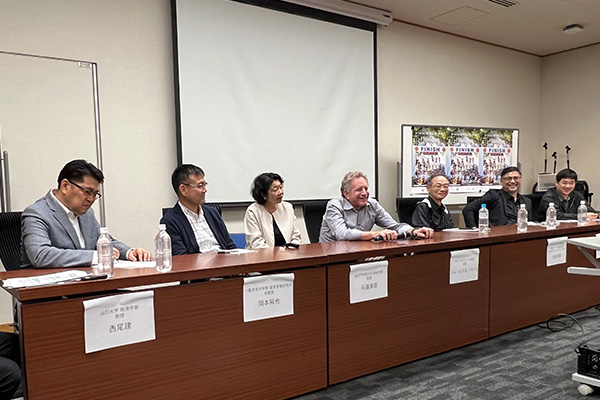|
第1回スポーツイベントサービス価値研究報告会レポート「スポーツイベントの新たな価値創造を目指して」 |
第1回スポーツイベントサービス価値研究報告会(東京) > 研究会の詳細はこちら
The 1st Research Group Meeting on the Value of Sport Event Services
テーマ:スポーツイベントの新たな価値創造を目指して
ゲスト:ジェームス S. バラハル(ホノルルマラソン協会(Honolulu Marathon Association)会長)
北村 次郎(ホノルルマラソン協会 日本・アジア地区担当 エグゼクティブ・ディレクター /
株式会社HM-A 代表取締役)
報告者:西尾 建(プロジェクトリーダー / 山口大学 経済学部 観光政策学科 教授)
湯浅 伸昭(ホノルルマラソン日本事務局 ディレクター)
三日市 勝臣(ホノルルマラソン日本事務局 マーケティングプランナー)
岡本 純也(一橋大学大学院 経営管理研究科 准教授)
石盛 真徳(追手門学院大学 経営学部 教授)
日 程:2024年5月20日(月)14:30-17:00
場 所:一橋大学 千代田キャンパス
TOPIC: The Creation of New Value for Sports Events
Guest: James S. Barahal, M.D.(Honolulu Marathon Association, President/CEO)
Jiro Kitamura (Honolulu Marathon Association Executive Director, Japan and Asia /
Representative Director, HM-A Inc.)
Presenter: Tatsuru Nishio (Project Leader: Professor / Faculty of Economics, Yamaguchi University)
Nobuaki Yuasa (Director, Honolulu Marathon Japan Office)
Katsuomi Mitsukaichi (Marketing Planner, Honolulu Marathon Japan Office)
Junya Okamoto (Associate Professor, Graduate School of Business Administration,
Faculty of Commerce and Management, Hitotsubashi University)
Masanori Ishimori (Professor Otemon Gakuin University)
Date and Time: 20May2024, 1430-1700
Location: Hitotsubashi University, Chiyoda Campus
【報告会レポート】
 第1回研究会キックオフは、ゲストとして、世界最大の市民マラソンのひとつであり長期にわたって多くの日本人ランナーも魅了しているホノルルマラソン協会のジム・バラハル会長と日本事務局代表北村次郎氏を招いて開催した。来場者は、研究者をはじめメディア、旅行会社、自治体やマラソン運営者など17名の参加があった。
第1回研究会キックオフは、ゲストとして、世界最大の市民マラソンのひとつであり長期にわたって多くの日本人ランナーも魅了しているホノルルマラソン協会のジム・バラハル会長と日本事務局代表北村次郎氏を招いて開催した。来場者は、研究者をはじめメディア、旅行会社、自治体やマラソン運営者など17名の参加があった。
第1部は北村、バラハル両氏からホノルルマラソンの概要、歴史、経済効果、地域貢献などについての紹介があった。ホノルルマラソンは1973年に心臓病のリハビリとしてわずか162人で始まった大会であったが、昨年大会までで延べ981,922人参加(日本人延べ約481,504人)の大会に成長した。大会は制限時間が無く、7歳以上ならだれでも参加可能。インターナショナルな大会でさまざまな国籍やハンディキャップを持った人々などで創り上げる共鳴、共感の場になっている。経済効果としても、ハワイ閑散期の旅行需要の創出、大会開催に関連する雇用創出、スポンサーとメディア効果、ランナーおよび同行者の観光消費による税収の増加など、ハワイの地域経済への効果について説明があった。
 第2部の研究報告では、西尾(山口大学)から大会に参加した日本人ランナーに関する発表。構造方程式モデルを使ってランナーに提供した「大会サービス」と「観光サービス」が「満足度」と「再マラソン意図」への影響を性別や参加回数別ロイヤルティーの段階別選好に分析。石盛(追手門学院大学)からボランティア活動のシステマチックレビューと岡本(一橋大学)からユニバーサル環境とランニング人口のトレンドについて発表があった。
第2部の研究報告では、西尾(山口大学)から大会に参加した日本人ランナーに関する発表。構造方程式モデルを使ってランナーに提供した「大会サービス」と「観光サービス」が「満足度」と「再マラソン意図」への影響を性別や参加回数別ロイヤルティーの段階別選好に分析。石盛(追手門学院大学)からボランティア活動のシステマチックレビューと岡本(一橋大学)からユニバーサル環境とランニング人口のトレンドについて発表があった。
研究メンバーにゲストを加えてのパネルディスカッションでは、①大会を支え盛り上げているボランティアと②日本人ランナーのトレンドとスポンサーシップについて議論した。ランナーのアンケート調査からも高いサービス価値が示されたコースのホスピタリティーを支えるボランティアについて、企業中心のボランティア運営から地元のスポーツクラブなどを中心にした「コミュニティーモデル」へ切り替えていった経緯や、病院や医師を中心とする「メディカルボランティア」や警察のコミットメントや「ミリタリーボランティア」などの紹介があった。フロアからの「自治体の関与」に関する質問については、ホノルルマラソンでは行政職員のコミットメントがほとんどなく、行政が深くかかわっている日本のマラソン大会と民間中心でのハワイのマラソン大会との違いについても議論した。
日本人ランナーの変遷に関しての議論では、北村氏が「40年の変遷の中で女性ランナーの増加や拡大期にTV番組の放映や日本航空をはじめとする持続的なスポンサードなどがハワイのデスティネーションの魅力とマッチして参加者が拡大していった」と語った。また湯浅氏は、消費者の動向が「モノ⇒コト⇒トキ」と変化していく中でホノルルマラソンでの経験を「トキ」消費ととらえ、スポーツツーリズムのコンセプトの中で「ランナーにとってホノルルマラソンが年間の生活サイクルの中に組み込まれている」というリピーターであるホノルルマラソンファンの特徴について述べた。大会のフィロソフィーについてバラハル氏は「伝統を重んじつつ、時代の変化に対応するために、カスタマー(バラハル氏はランナーをカスタマーと表現)の動向や要望を常に把握することを重視している」と語った。
ホノルルマラソン協会と日本事務局とのチームワークで取り組んでいるマーケティングアプローチは日本のスポーツイベントの運営にも多くの示唆があった。バラハル氏のマーケティング外部環境に対する柔軟で迅速な対応と、なにより大会に対するパッションを強く感じた。


(文責:西尾 建)
Report:
The first kick-off of our Research Project Group was held with guests Dr. Jim Barahal, President/CEO of the Honolulu Marathon Association, and Mr. Jiro Kitamura, Honolulu Marathon Japan Office Representative. Seventeen visitors attended, including researchers, media, travel agents, local authorities, and marathon organizers.
In the first part of the event, Mr. Kitamura and Dr. Barahal provided an overview of the Honolulu Marathon, covering its history, economic impacts, and contributions to the local community. The Honolulu Marathon started in 1973 with only 162 participants as a rehabilitation event for heart disease patients. By last year, the event had grown to a total of 981,922 participants, including 481,504 Japanese. The event is open to anyone aged 7 and over with no time limit, and it has become an international event that fosters resonance and empathy among people of various nationalities and abilities. They also explained the economic effects on Hawaii’s local economy, such as the creation of travel demand during the off-season, job creation related to the event, sponsorship and media impacts, and increased tax revenues through tourism spending by runners and their companions.
In the second part of the research report, Prof. Nishio (Yamaguchi University) presented on Japanese runners who participated in the marathon. The analysis used Structural Equation Modelling to examine the impact of ‘event services’ and ‘tourism services’ provided to runners on ‘satisfaction’ and ‘intention to run the marathon again’ with preferences by gender and stage of loyalty. Prof. Ishimori (Otemon Gakuin University) presented a systematic review of volunteer activities, and Associate Prof. Okamoto (Hitotsubashi University) discussed universal environments and trends in the running population.
A panel discussion with research members and two guests addressed (i) volunteers who support and enliven the event, and (ii) trends and sponsorship of Japanese runners. The discussion highlighted the high service value of the volunteers, as demonstrated by a runners’ survey, and included a shift from corporate-centered volunteer management to a “Community Model” centered on local sports clubs. The roles of “medical volunteers,” including hospitals and doctors, and the police’s commitment to “medical volunteering” were introduced. In response to a question about the involvement of local authorities, it was noted that there was almost no commitment from city-council officials at the Honolulu Marathon, contrasting with Japanese marathons, where government or city council involvement is significant, and Hawaii’s marathons, which focus on private activities.
Discussing the long-term trends of Japanese runners, Mr. Kitamura noted that over the past 40 years, the number of female runners has increased. During the expansion period, the number of participants grew as the appeal of the Hawaiian destination matched the appeal of Special TV programs broadcasts and sustained sponsorship by Japan Airlines and other companies. Mr. Yuasa also explained that as consumer trends shift from ‘MONO => KOTO => TOKI’, the Honolulu Marathon experience is seen as ‘TOKI’ consumption, and within the concept of sports tourism, ‘the Honolulu Marathon is integrated into the annual life cycle for runners’, making them repeat participants. The characteristics of Honolulu Marathon fans were described. Regarding the event’s philosophy, Dr. Barahal stated, ‘We place emphasis on keeping an eye on the trends and demands of our customers (he referred to runners as customers) to respond to changing market trends while respecting tradition.’
The marketing approach, a collaborative effort between the Honolulu Marathon Association and the Japan Office, had many implications for the management of sporting events in Japan. I was particularly struck by Dr. Barahal’ s flexible and quick response to the external marketing environment and, above all, his passion for the event.
(by Tatsuru Nishio)












